 Technology peripherals
Technology peripherals
 AI
AI
 Others are still putting out 'big model' satellites, but Microsoft has already taught developers how to use them
Others are still putting out 'big model' satellites, but Microsoft has already taught developers how to use them
Others are still putting out 'big model' satellites, but Microsoft has already taught developers how to use them
The turn of spring and summer is the season when the world’s top technology companies hold annual events. Two weeks ago it was Google, and this week it's finally Microsoft's turn. In just 43 minutes, Microsoft Chairman and CEO Satya Nadella completed the keynote speech at this year's Build 2022 conference. As if talking about Allegro, he released more than 50 new products, technologies and project progress of Microsoft in ten major fields such as developer process, cloud computing, microservices, commercialization of AI large models, low code, and industrial metaverse.
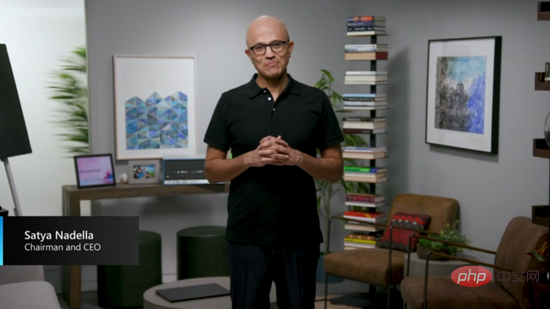
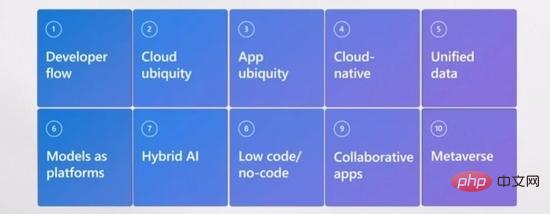
The most noteworthy new releases include:
- Successful commercialization using OpenAI technology OpenAI Services, a large model service;
- The low-code/no-code development platform driven by machine learning algorithms and the GitHub Copilot AI code assistant are officially open to the public;
- An attempt in the industrial metaverse;
- For Windows On ARM developers launched the development prototype Project Volterra;
- Office collaboration software Teams newly launched Live Share real-time collaboration "small Program” platform; etc.
Among the large number of new releases, most of them can be attributed to the following three key angles:
- Through the assistance of AI and AI tools, let Developers and business users can be freed from the burden of tools, such as GitHub Copilot code generation tool, cross-device synchronized development environment virtual machine Dev Box, etc.); ) to provide developers with full "AI-integrated application" development capabilities, such as ARM architecture development and testing prototype Project Volterra, Azure cloud computing machine learning services, etc.;
- Use AI-driven automation technology , to further improve office efficiency, such as low-code web app generation tool Power Pages, customer service-consumer dialogue summary generation tool Text Summarization, etc.
- It can be seen from these perspectives that co-founder and former CEO Ballmer’s ambition to shout "Developers! Developers! Developers!"
Microsoft Still holding on. Only if developers continue to support and participate in building Microsoft-led enterprise services and cloud computing ecosystem can the company continue to gain a foothold and avoid becoming the next HP /Yahoo. Let’s find out from Silicon Stars what important developer tools Microsoft released today.
Let large models be commercialized and become a tool for developers
When OpenAI launched GPT-3 before, many third-party developers obtained testing permissions and made many Very creative demo.
However, no one has more "advanced" permissions than Microsoft. Microsoft sees great commercialization prospects in GPT-3, as well as OpenAI's many efforts in large-scale/very large-scale generative languages and multi-modal models. In 2019, OpenAI and Microsoft have reached a strategic partnership.
Of course, I am afraid that only Microsoft, which is well versed in the office and enterprise markets, can truly and efficiently turn these technologies into an engine that drives business growth.
At today's Build conference, we saw that the cooperation between Microsoft and OpenAI has finally come to fruition: Microsoft Azure cloud computing platform officially launched OpenAI Services (preview version), developers can apply to trial this service, and in a large number of In different usage scenarios, large models of code generation and language generation developed by OpenAI are applied.
In one sentence, all applications can be supported by large AI models.
Azure OpenAI Services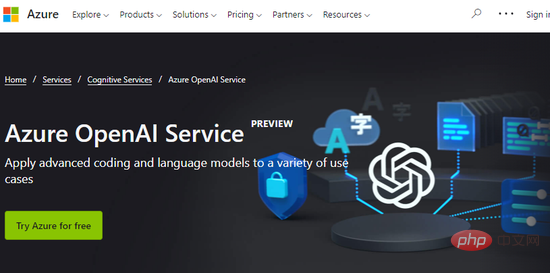 Take the online used car sales platform CarMax as a case:
Take the online used car sales platform CarMax as a case:
When purchasing used cars, consumers always face "information overload" "Looking at hundreds of vehicle technical details and comments, it is very headache for non-professionals. The company CarMax is using Azure OpenAI Services, while using the powerful "reading comprehension" capabilities of GPT-3 and the enterprise-level service capabilities of the Azure cloud computing platform to generate refined information about vehicles.
Now, CarMax users can use the "paragraph" summarized by the model to understand the situation of the vehicle that is closest to reality, such as how many people can be accommodated, space size and comfort, fuel economy, etc. OpenAI Services effectively reduces the psychological pressure of CarMax users during the car purchase process, reduces transaction friction, and increases the probability of closing a transaction.
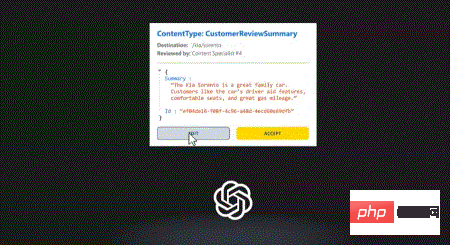 Carmax adopts Azure OpenAI Services diagram. Animation source: Microsoft
Carmax adopts Azure OpenAI Services diagram. Animation source: Microsoft
One more thing worth mentioning: Express Design, a low/no-code development feature. With this technology, you can directly transform a design draft into a working application interface or even a complete application in just a few seconds.
Express Design is one of the features of Microsoft’s low-code development tool Power Apps. It supports a variety of file formats including Figma files, PDF, ppt and other document formats, and even hand-drawn drafts. Behind it are also language generation and multi-modal models developed by Microsoft itself and partners including OpenAI.
Developer users of Power Apps can start using Express Design features today.
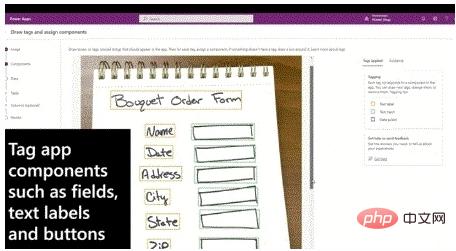
#Express Design can directly convert design drafts into usable application prototype interfaces in just a few seconds. Source of animation: Microsoft
As mentioned earlier, we have indeed seen many interesting and potential demos in the past, but the actual application of large models has always been a problem for R&D institutions.
Combine ultra-large models with the Azure cloud computing platform to achieve large-scale automated creation of code and content - this is also the meaning of the "Model as Platforms" concept proposed by Microsoft this year.
It can be said that the various OpenAI Demo two years ago allowed us to see the potential of language generation models with extremely large parameter quantities. What Microsoft is doing today is not only to put large models into the hands of developers, but more importantly, to teach them how to further unlock the potential of large models. The commercialization of large models is not as simple as opening an API. After all, it is still a brand-new thing. If you teach it to fish, you must teach it to fish.
Through technical services and functions such as Azure OpenAI Services and Express Design, Microsoft has become the first to eat the big model crab.
Video conferencing "sharing pictures" has become more high-tech!
Since the epidemic, everyone should have become accustomed to home/remote working and video conferencing. When explaining slides in meetings, I believe many people often use the share screen function.
However, in the view of Microsoft's office collaboration software Teams team, many industry companies are now working remotely, and they need to complete more complex collaboration tasks on a variety of software. Such needs cannot be met." "Passive" screen sharing function is enough.
To this end, Teams launched the Live Share feature this year.
Live Share is not a replacement for screen sharing, but can be regarded as an "advanced" version of the screen sharing function. Specifically, Live Share inserts a third-party application interface into the video conference - a bit like a remote desktop, which not only allows viewing, but also allows all participants to interact.
Take the 3D modeling software Hexagon in the figure below as an example: a Live Share screen can be initiated in a Teams video conference, and other participants can edit and observe the 3D model from their own angles. This more intuitive collaboration experience allows participants to participate in brainstorming more intuitively.
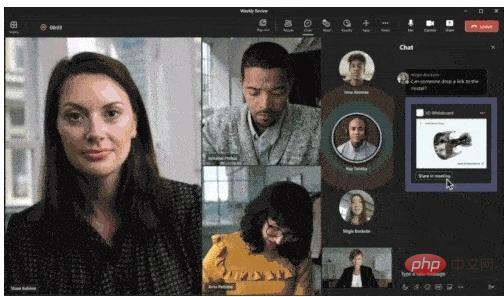
Teams’ newly launched Live Share real-time collaboration function allows complex and interactive third-party programs to be embedded into meetings, greatly expanding screen sharing in video conferences Operability Animation source: Microsoft
Take the simplest scenario:
An application development team is demonstrating a round product, and you want to see application menu clicks and icon dragging In the past, you had to raise your hand to speak and tell the speaker to do the operation for you;
With Live Share, you can now operate on your own screen, and each participant can perform different operations at the same time. The operation does not affect the picture seen by others. In this way, not only did everyone have a deeper understanding of the presentation content, but it also significantly shortened the meeting time.
(In developer language: Live Share is like turning the content of the demonstration into a virtualized instance, and each participant can get his or her own instance.)
## The #Live Share function is based on the Front-end Framework developed by Microsoft. Third-party application developers only need to integrate Microsoft's newly launched Live ShareSDK into their products to enable their applications to support this function. Functions can be implemented through Live Share, including basic interface interaction, audio and video content synchronization, multi-user editing, etc., as well as for planning poker (agile poker), etc. Partners for the feature include video collaboration service Frame.io, design firm Hexagon, consulting firm Accenture, planning poker service Parabol and others. It can be expected that with the Live Share function, more developers and intensive collaboration teams will prefer Teams when choosing office collaboration and video conferencing solutions.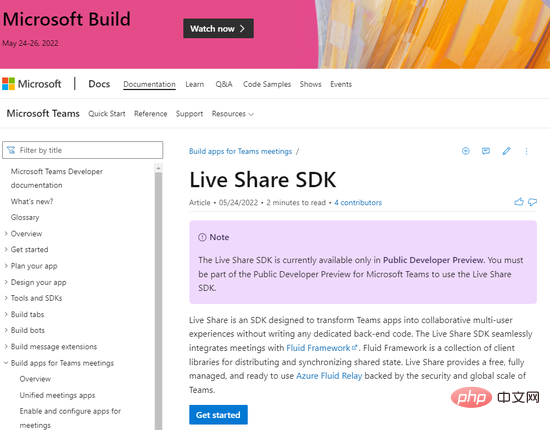
For new platform/cross-platform developers, provide an open hardware ecosystem
When open source was discussed more than ten years ago, I am afraid that few people would use Microsoft as a positive case. However, since 2015, from open source .NET to Visual Studio supporting multi-operating system/language development, to strategic acquisition and technical support for GitHub, Microsoft has become an open technology One of the most active and important contributors in the field of ecology.
As a vested interest in the Wintel alliance, Microsoft is not shy about the decline of the x86 computing platform. Over the past few years, Microsoft has proven itself in supporting multi-platform development. At this Build conference, the company took another key step in supporting the open hardware ecosystem.
Today, Microsoft launched Project Volterra, an ARM architecture, developer kit:
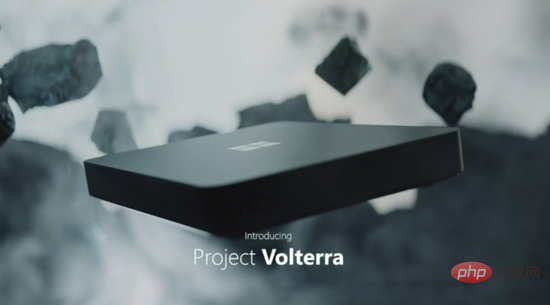
"We believe in Windows openness The hardware ecosystem can give developers more flexibility and choices, helping them develop products that can support a variety of scenarios," Microsoft said. Project Volterra is such a product based on helping ARM architecture developers.
Project Volterra uses the Snapdragon NPU computing platform and has a built-in neural computing unit (NPU) that Qualcomm has promoted in recent years, which can achieve inference and some training work on machine learning models with lower power consumption. This developer prototype runs Windows on ARM and is suitable for developers whose primary work environment is Windows or Windows Subsystem for Linux.
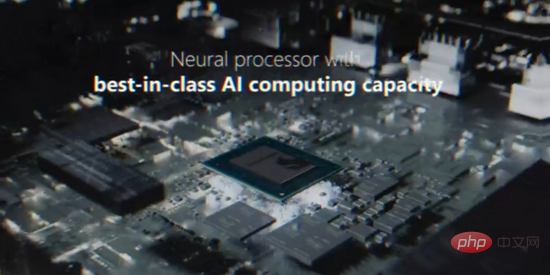
Project Volterra integrates multiple I/O interfaces, and Microsoft claims that this development machine adopts a stackable design, which seems to mean that multiple machines can be stacked to achieve A workload model similar to parallel computing:

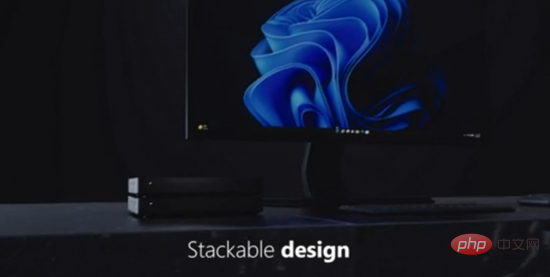
In the past ten years, Microsoft’s own Surface Device attempts at Windows on ARM have not achieved results worth bragging about, and some attempts have even failed miserably, such as the Surface RT in the past few years and the Neo/Duo dual-screen devices in the past two years.
In an era when the x86 computing platform is declining, the ARM architecture is still undoubtedly the most important computing platform in the consumer and Internet of Things markets. Microsoft did not give up on the ARM market because of its failure. Just like the open source campaign in previous years, this company is crazily embracing the ARM architecture today:
In addition to Project Volterra, Microsoft also announced that it will implement end-to-end support for the ARM architecture on the entire Windows platform. Provides a series of ARM native tool chains, including but not limited to Visual Studio/VSCode, Visual C, NET Framework, etc.
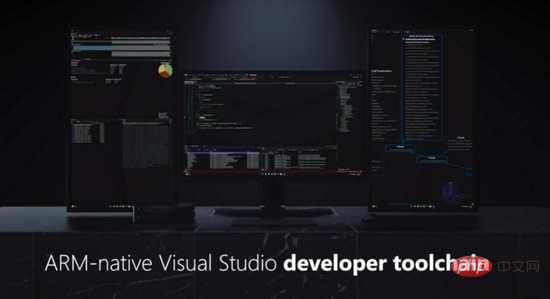

Based on its strong support for the ARM/Snapdragon NPU computing platform, Microsoft is currently planning a grand plan: Hybrid Loop.
Hybrid Loop is a cross-platform AI development model. Its ultimate goal is to use the power of Azure ML and ONNX Runtime (compatible with multiple neural network frameworks) to allow any neural network model to be used in any application , and deployed on a variety of mainstream computing hardware platforms such as CPU, GPU, NPU, FPGA, etc.
Project Volterra is an attempt at this great plan.
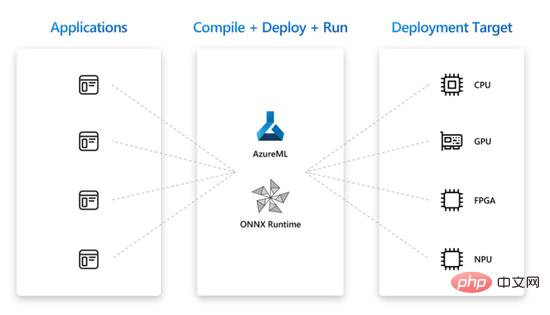
The above are the new products and technologies that we think are particularly worth talking about at this year’s Build Conference. As mentioned at the beginning of the article, this year's keynote speech released more than 50 new gadgets in 10 major categories in 43 minutes. If you are interested in learning about all the projects, you can visit Microsoft's official website.
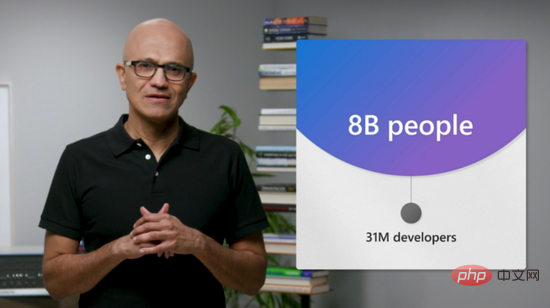
But I would like to add one last thing: One of the features of this year’s Build Developer Conference is “no futures selling”. The vast majority of the more than 50 new releases this time will be open to developers and the public to varying degrees after the conference.
You can watch the video replays of the Build conference keynote speech and sub-session on Microsoft's official website, and learn about more technologies and product releases not mentioned in this article.
The above is the detailed content of Others are still putting out 'big model' satellites, but Microsoft has already taught developers how to use them. For more information, please follow other related articles on the PHP Chinese website!

Hot AI Tools

Undresser.AI Undress
AI-powered app for creating realistic nude photos

AI Clothes Remover
Online AI tool for removing clothes from photos.

Undress AI Tool
Undress images for free

Clothoff.io
AI clothes remover

AI Hentai Generator
Generate AI Hentai for free.

Hot Article

Hot Tools

Notepad++7.3.1
Easy-to-use and free code editor

SublimeText3 Chinese version
Chinese version, very easy to use

Zend Studio 13.0.1
Powerful PHP integrated development environment

Dreamweaver CS6
Visual web development tools

SublimeText3 Mac version
God-level code editing software (SublimeText3)

Hot Topics
 1377
1377
 52
52
 Laravel's geospatial: Optimization of interactive maps and large amounts of data
Apr 08, 2025 pm 12:24 PM
Laravel's geospatial: Optimization of interactive maps and large amounts of data
Apr 08, 2025 pm 12:24 PM
Efficiently process 7 million records and create interactive maps with geospatial technology. This article explores how to efficiently process over 7 million records using Laravel and MySQL and convert them into interactive map visualizations. Initial challenge project requirements: Extract valuable insights using 7 million records in MySQL database. Many people first consider programming languages, but ignore the database itself: Can it meet the needs? Is data migration or structural adjustment required? Can MySQL withstand such a large data load? Preliminary analysis: Key filters and properties need to be identified. After analysis, it was found that only a few attributes were related to the solution. We verified the feasibility of the filter and set some restrictions to optimize the search. Map search based on city
 How to solve mysql cannot be started
Apr 08, 2025 pm 02:21 PM
How to solve mysql cannot be started
Apr 08, 2025 pm 02:21 PM
There are many reasons why MySQL startup fails, and it can be diagnosed by checking the error log. Common causes include port conflicts (check port occupancy and modify configuration), permission issues (check service running user permissions), configuration file errors (check parameter settings), data directory corruption (restore data or rebuild table space), InnoDB table space issues (check ibdata1 files), plug-in loading failure (check error log). When solving problems, you should analyze them based on the error log, find the root cause of the problem, and develop the habit of backing up data regularly to prevent and solve problems.
 How to use mysql after installation
Apr 08, 2025 am 11:48 AM
How to use mysql after installation
Apr 08, 2025 am 11:48 AM
The article introduces the operation of MySQL database. First, you need to install a MySQL client, such as MySQLWorkbench or command line client. 1. Use the mysql-uroot-p command to connect to the server and log in with the root account password; 2. Use CREATEDATABASE to create a database, and USE select a database; 3. Use CREATETABLE to create a table, define fields and data types; 4. Use INSERTINTO to insert data, query data, update data by UPDATE, and delete data by DELETE. Only by mastering these steps, learning to deal with common problems and optimizing database performance can you use MySQL efficiently.
 Can mysql return json
Apr 08, 2025 pm 03:09 PM
Can mysql return json
Apr 08, 2025 pm 03:09 PM
MySQL can return JSON data. The JSON_EXTRACT function extracts field values. For complex queries, you can consider using the WHERE clause to filter JSON data, but pay attention to its performance impact. MySQL's support for JSON is constantly increasing, and it is recommended to pay attention to the latest version and features.
 MySQL can't be installed after downloading
Apr 08, 2025 am 11:24 AM
MySQL can't be installed after downloading
Apr 08, 2025 am 11:24 AM
The main reasons for MySQL installation failure are: 1. Permission issues, you need to run as an administrator or use the sudo command; 2. Dependencies are missing, and you need to install relevant development packages; 3. Port conflicts, you need to close the program that occupies port 3306 or modify the configuration file; 4. The installation package is corrupt, you need to download and verify the integrity; 5. The environment variable is incorrectly configured, and the environment variables must be correctly configured according to the operating system. Solve these problems and carefully check each step to successfully install MySQL.
 Remote senior backend engineers (platforms) need circles
Apr 08, 2025 pm 12:27 PM
Remote senior backend engineers (platforms) need circles
Apr 08, 2025 pm 12:27 PM
Remote Senior Backend Engineer Job Vacant Company: Circle Location: Remote Office Job Type: Full-time Salary: $130,000-$140,000 Job Description Participate in the research and development of Circle mobile applications and public API-related features covering the entire software development lifecycle. Main responsibilities independently complete development work based on RubyonRails and collaborate with the React/Redux/Relay front-end team. Build core functionality and improvements for web applications and work closely with designers and leadership throughout the functional design process. Promote positive development processes and prioritize iteration speed. Requires more than 6 years of complex web application backend
 Understand ACID properties: The pillars of a reliable database
Apr 08, 2025 pm 06:33 PM
Understand ACID properties: The pillars of a reliable database
Apr 08, 2025 pm 06:33 PM
Detailed explanation of database ACID attributes ACID attributes are a set of rules to ensure the reliability and consistency of database transactions. They define how database systems handle transactions, and ensure data integrity and accuracy even in case of system crashes, power interruptions, or multiple users concurrent access. ACID Attribute Overview Atomicity: A transaction is regarded as an indivisible unit. Any part fails, the entire transaction is rolled back, and the database does not retain any changes. For example, if a bank transfer is deducted from one account but not increased to another, the entire operation is revoked. begintransaction; updateaccountssetbalance=balance-100wh
 Laravel Eloquent ORM in Bangla partial model search)
Apr 08, 2025 pm 02:06 PM
Laravel Eloquent ORM in Bangla partial model search)
Apr 08, 2025 pm 02:06 PM
LaravelEloquent Model Retrieval: Easily obtaining database data EloquentORM provides a concise and easy-to-understand way to operate the database. This article will introduce various Eloquent model search techniques in detail to help you obtain data from the database efficiently. 1. Get all records. Use the all() method to get all records in the database table: useApp\Models\Post;$posts=Post::all(); This will return a collection. You can access data using foreach loop or other collection methods: foreach($postsas$post){echo$post->



